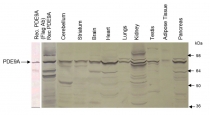ARG10812
anti-PDE9A antibody
anti-PDE9A antibody for Confocal microscopy (Confocal),Dot blot,ELISA,ICC/IF,IHC-Formalin-fixed paraffin-embedded sections,Immunoprecipitation,Western blot and Human,Mouse,Rat
Overview
| Product Description | Rabbit Polyclonal antibody recognizes PDE9A |
|---|---|
| Tested Reactivity | Hu, Ms, Rat |
| Tested Application | Confocal, Dot, ELISA, ICC/IF, IHC-P, IP, WB |
| Host | Rabbit |
| Clonality | Polyclonal |
| Isotype | IgG |
| Target Name | PDE9A |
| Antigen Species | Human |
| Immunogen | Synthetic cyclic peptide common to all PDE9A variants. |
| Conjugation | Un-conjugated |
| Alternate Names | High affinity cGMP-specific 3',5'-cyclic phosphodiesterase 9A; EC 3.1.4.35; HSPDE9A2 |
Application Instructions
| Application Suggestion |
|
||||||||||||||||
|---|---|---|---|---|---|---|---|---|---|---|---|---|---|---|---|---|---|
| Application Note | * The dilutions indicate recommended starting dilutions and the optimal dilutions or concentrations should be determined by the scientist. |
Properties
| Form | Liquid |
|---|---|
| Purification | Affinity purified. |
| Buffer | Tris-Glycine Buffer (pH 7.4 - 7.8), Hepes, 0.02% Sodium azide, 30% Glycerol and 0.5% BSA. |
| Preservative | 0.02% Sodium azide |
| Stabilizer | 30% Glycerol and 0.5% BSA |
| Concentration | 0.5 mg/ml |
| Storage Instruction | For continuous use, store undiluted antibody at 2-8°C for up to a week. For long-term storage, aliquot and store at -20°C. Storage in frost free freezers is not recommended. Avoid repeated freeze/thaw cycles. Suggest spin the vial prior to opening. The antibody solution should be gently mixed before use. |
| Note | For laboratory research only, not for drug, diagnostic or other use. |
Bioinformation
| Database Links | |
|---|---|
| Gene Symbol | PDE9A |
| Gene Full Name | phosphodiesterase 9A |
| Background | The protein encoded by this gene catalyzes the hydrolysis of cAMP and cGMP to their corresponding monophosphates. The encoded protein plays a role in signal transduction by regulating the intracellular concentration of these cyclic nucleotides. Multiple transcript variants encoding several different isoforms have been found for this gene. [provided by RefSeq, Jul 2008] |
| Function | Specifically hydrolyzes the second messenger cGMP, which is a key regulator of many important physiological processes. Highly specific: compared to other members of the cyclic nucleotide phosphodiesterase family, has the highest affinity and selectivity for cGMP. Specifically regulates natriuretic-peptide-dependent cGMP signaling in heart, acting as a regulator of cardiac hypertrophy in myocytes and muscle. Does not regulate nitric oxide-dependent cGMP in heart. Additional experiments are required to confirm whether its ability to hydrolyze natriuretic-peptide-dependent cGMP is specific to heart or is a general feature of the protein (Probable). In brain, involved in cognitive function, such as learning and long-term memory (By similarity). [UniProt] |
| Calculated MW | 68 kDa |
Images (2) Click the Picture to Zoom In
-
ARG10812 anti-PDE9A antibody WB image
Western blot: Recombinant PDE9A protein stained with ARG10812 anti-PDE9A antibody at 1:500 dilution.
-
ARG10812 anti-PDE9A antibody WB image
Western blot: PDE9A on SDS-PAGE showing tissue distribution of PDE9A. The blots were stained with ARG10812 anti-PDE9A antibody at 1:1000 dilution.







